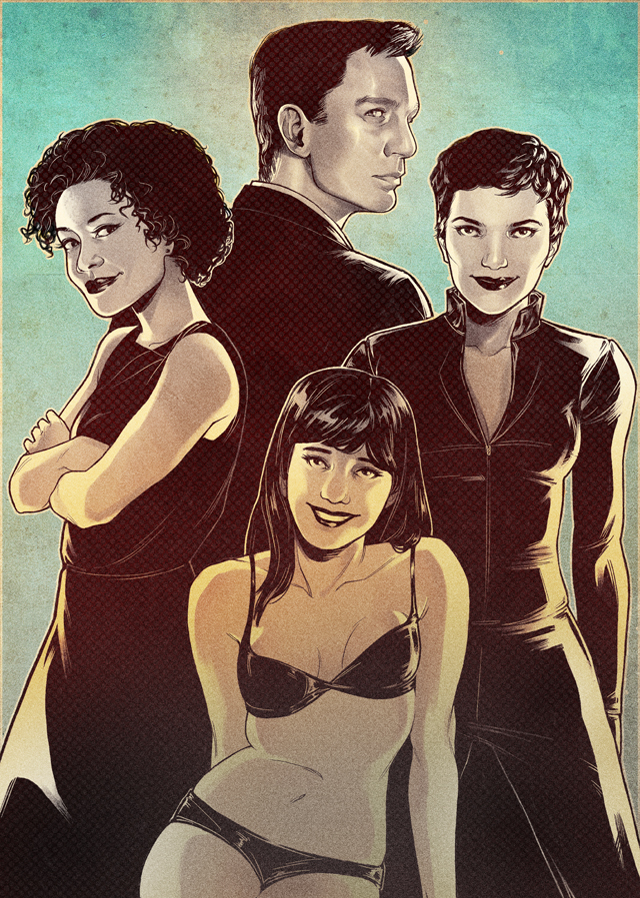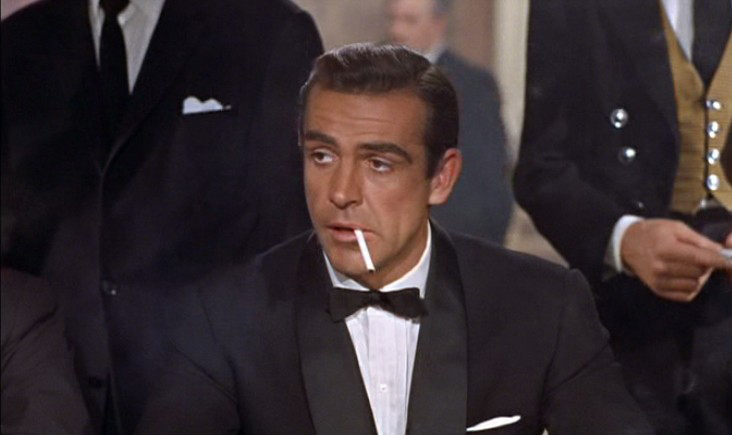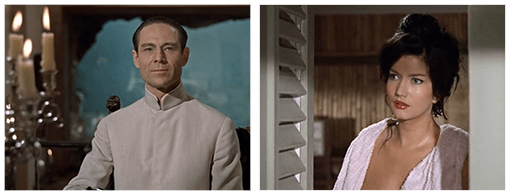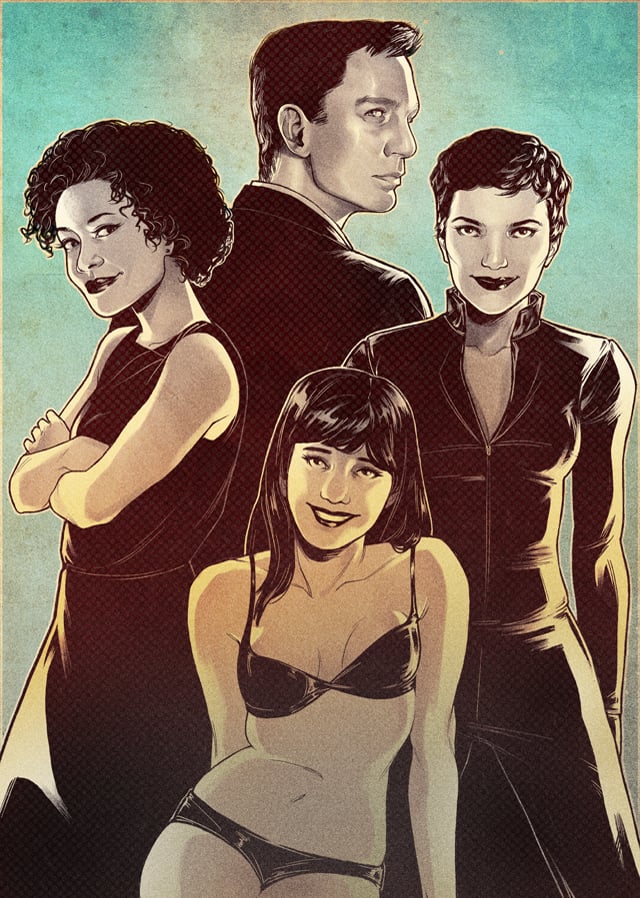
Original illustration by Emilie Majarian for The Mary Sue.
Welcome to Bond Girl, a new series where we’ll be re-watching and re-evaluating every James Bond film until Spectre’s release. Please note the following content warnings: mentions of sexual assault in canon, racism, yellowface, and whitewashing.
Bond. James Bond.
I’ve been watching James Bond films since I was a kid.
The series was one of those things that I was into despite it being wholly inappropriate for my age. (Other things I liked at age eight were Dean Koontz novels and soap operas like All My Children, so you can tell that I had great taste in potentially traumatizing media from a very young age).
Watching the older James Bond films as a kid, however, is an entirely different experience from watching them as an adult.
At twenty-four I get all (okay, most) of the jokes, and I now have complicated feelings for Sean Connery. But that’s only the good stuff. At eleven, I wasn’t aware of the world around me. I didn’t know about imperialism yet, and saw the world in black and white. Shades of gray, like the world in which James Bond actually lives, didn’t exist to me at that point.
So this rewatch of James Bond, where I’m actively looking for things that I would have passed me by, has me noticing all of the things that I missed as a little kid. Some of the things I’m noticing are good.
Others are kind of awful.

Dr. No is the first James Bond movie, and is based on the sixth Ian Fleming James Bond book. It focuses on Bond trying to find out what the titular Dr. No is plotting after it comes to light that he’s killed two MI6 agents that knew too much. The metal-handed Dr. No’s plans to disrupt an American missile launch using 1960s tech are… decent, at the very least, and he’s a very good villain up until he dies by boiling to death after the film’s big fight scene. It’s a good movie, but I’m going to be honest, watching it now I’m more focused on the characters’ relationships than on the fight scenes.
Watching Dr. No is kind of like a shock to me now, because I’m coming up against things that are at odds with my fuzzy recollection of the movie. I’m adult now, and a feminist on top of that, so I’m noticing things about the dynamics between men and women as well as those between the predominantly white cast and the sprinkling of people of color that show up in the movie and have meaningful dialogue.
It’s… not the best set of dynamics. It’s so weird, because, over all, Dr. No somehow manages to be simultaneously more and less diverse than you’d expect it to be. While I sort of remembered the hypersexualized images of the women in the film from my earlier watches, I really didn’t get the racism until recently.
As much as I love James Bond, and as much as I enjoyed Dr. No, the two things that get to me are the portrayals of women and the racism. It’s a movie set in Kingston, Jamaica, so you have a good amount of Black and Chinese actors and extras in the film; unfortunately, most of these actors and extras have one thing in common.
They’re largely framed as the “help” or henchmen.

Dr. No is an hour and fifty minutes long. Less than ten characters of color show up more than once in the movie, and only about half of them have anything that remotely resembles a significant role in the movie.
We have the “Three Blind Men”, Jamaican assassins (played by Eric Coverly, Charles Edghill, and Henry Lopez) who work for the titular Dr. No, and are mostly silent. I don’t think they even get individual names before they wind up dying in a car crash halfway through the film.
Marguerite LeWars (Miss Jamaica at the time) was an unnamed photographer working for Dr. No. She has two appearances. The first is silent but sexualized (the camera zooms in on her licking a lightbulb for her camera, which was one of many things that the actress was not comfortable doing in her role). The second sees her manhandled by another (Black) character and threatened by both him and James Bond. It’s not exactly the stuff of legends. She doesn’t even get a name in the movie.
Quarrel on the other hand, played by expat John Kitzmiller, is a really good example of how Dr. No makes me feel conflicted when I look at the diversity in the film. Quarrel is a great help to James Bond. He has a decent amount of dialogue, and he has Bond’s back up until a critical scene that ends in his death
The way that Quarrel is framed, however, is so frustrating to me at times. Quarrel is definitely supposed to be a gently oafish figure; he’s clumsily brutish and looks to Bond and the CIA agent Felix Leiter (Jack Lord) for orders, referring to them as “captain” in this subservient tone of voice as he moves to do what they want him to. This feeling that he’s in some way not as important as Leiter and Bond when sharing a screen with them carries through the film.
There’s a set up where the trio is talking about the suspicious island of Crab Key and Quarrel goes: “You see, there’s a dragon” as his reason for not wanting to go back to Crab Key. He says it straight and serious, only for Leiter’s delightfully condescending aside to Bond about the legend being “Native superstition.” To me, he’s portrayed as simple and needing guidance from the white male characters around them, the way that Africans were portrayed in the pulps and comics written back in their respective golden ages and that was pretty jarring to realize.
But that’s not the only issue: Dr. No has a serious yellowface problem on top of their regular old villain one.

The titular Dr. No is supposed to be half-Chinese and half-German.
Supposed to be.
Instead, he’s played by Joseph Wiseman, who wore makeup in order to appear Chinese. You know, because there were no Chinese actors available in the 1960s for anything aside from background parts or villainous henchmen (?). Wiseman is a great actor, don’t get me wrong; he’s so creepy as Dr. No, and has this subtly menacing air to him, but let’s face it: he didn’t have to be Dr. No.
Aside from that, I actually like Dr. No. I love the mystery of him, how you don’t see his face until the film is almost over and then he’s this stark and gaunt figure. He has his bad guy image down pat: He’s a quietly menacing figure with serious boundary issues. (I still can’t figure out what he was looking at when he crept into Bond’s room prior to the climactic scene in the underground lair and lifted the bedsheet but it cracks me up every single time I think about it.) He’s looking for a challenge and he finds one in Bond. I’m still steamed about the fact that they couldn’t cast anyone else in the role, but I can’t help how much I like him as a bad guy.
Next we have Zena Marshall’s Miss Taro.
Unlike Dr. No, whom I knew was an actor in yellowface makeup from the start, it took me a few rewatches and a quick flip through Wikipedia to figure out that Miss Taro was also played by someone in yellowface. After LeWars’ photographer, Miss Taro feels like the second-worst treated lady in the film.
Miss Taro gets a name, sure, but she’s super sexualized. She comes to the door in her towel and then has Bond barrel into her house after surviving an attempt on his life. It’s implied that she sleeps with him, not because she wants to, but because she has to do something to keep Bond there in her house. We come to find out that Bond knew the entire time that Miss Taro was working for Dr. No. He could have confronted her earlier or had her arrested right after her super suspicious phone call; but nah, that’s not what James Bond is about. So none of their interactions really had to go the way that they did, and, offhand, I can think of several different ways that she could have been a slightly more fleshed-out character that was still sexy.
It’s weird to see these characters and know that they’re in makeup because the movie actually has extras of color. (Like later on in the film we actually see Chinese and Japanese actresses in one of the scenes, and I don’t get why they didn’t look to actual Asian women to play an Asian character.) The film has a bunch of extras who are Asian and yet, when it comes down to the Bond girl and the Bond villain, there’s nothing. Sure, Dr. No was very much a friends-and-family affair; everyone was so-and-so’s friend or family member and many of the cast and members were chosen because they had connections with the production team or Ian Fleming himself. Seriously, one of Fleming’s initial choices for Dr. No was his cousin (and all around badass) Christopher Lee. But I’m still a bit steamed over the fact that no one apparently knew any Chinese actors that could be up for the part.
Now, when it comes to the treatment of women in Dr. No, well, I’m always ready to talk about that. I could probably talk for days just about the women in this film. The portrayals of women of color were… not the best, but there are some core women in Dr. No that definitely do set the standard for the ones to come.

Three women in the film share a significant amount of screentime with James Bond and they each represent something different. You have your sophisticated society woman (in Eunice Gayson’s Sylvia Trench); the witty and unobtainable Moneypenny (played by Lois Maxwell); and Ursula Andress’s innocent and almost childlike Honey Ryder. These relationships for me are the biggest draw of the movie because it’s interesting to look at how the ladies are handled so differently from one another.
Out of the three, Moneypenny (above center) is my favorite lady in the film, hands down. She’s on mostly-even footing with Bond, and their back-and-forth in the MI6 scenes was hilarious. As much as I love Naomie Harris’s Moneypenny (as you’ll see when I get to Skyfall in my review), Lois Maxwell’s Moneypenny actually makes me laugh more, and I’m looking forward to the flirtation in all of her films in the series. She’s a safe character for Bond, someone with whom he flirts on instinct and who flirts back, but who knows him too well to actually turn the flirting into something serious.
Sylvia Trench is a close second though, because, while everyone is so focused on the iconic nature of James Bond delivering his introduction with a smirk and smug air, they forget that she did it first. She’s confident, cool, and goes after what she wants. My favorite scene in the entire film is the one where Sylvia’s kisses are enough to make Bond push back leaving for Jamaica. The two relationships that Bond does have afterwards don’t leave me feeling like they were on equal footing, but Sylvia feels like she has that with Bond. I don’t know if I want to smooch her or if I want to be her. She’s that great!

Now, I… I have to admit something.
Honey Ryder has never been my go-to for Bond girls. I always felt that she was too young for James Bond (really, that he was too old for her) and that the way that she’s portrayed in the film left a lot to be desired because I really wanted to protect her, not just from the bad guys, but from Bond himself.
And you know what? I’m still feeling that way. Honey is portrayed as this ultimate innocent, and I really don’t like the skeevy, almost paternalistic way that Bond comes on to her. Even when she’s describing taking revenge on the man that raped her, she has this moment of taking pleasure in how she killed him that loses its effect in the way that she immediately looks to Bond for reassurance.
Honey Ryder: I put a black widow spider underneath his mosquito net… a female, they’re the worst. It took him a whole week to die.
[Bond looks shocked despite killing people for less in this film so far]
Did I do wrong?
James Bond: Well, it wouldn’t do to make a habit of it.
We’re supposed to chuckle at the joke, but I’m so not laughing.
Honey is framed as this super sweet, super innocent character with no real worldly experiences until James Bond gives them to her. Sure, she’s killed a man, but it’s put forth as if she doesn’t understand the implications of her actions. Her relationship with Bond in the film makes me uncomfortable because there’s a part of my brain that keeps thinking of her as a baby (despite the fact that Ursula Andress was older then than I am now). Bond is this world-weary, womanizing beast, and she’s an orphan on her own with no connections and no protection beside him. There’s so much about their dynamic that rubs me the wrong way.
Overall, Dr. No isn’t a bad movie. Yeah, I have some major issues with the yellowface and the way that Honey Ryder and Marguerite LeWars’ characters are treated, but it’s not bad. In fact, aside from those things, I love this movie to pieces. I’m just looking forward to more well-rounded women and characters of color that make it to the end of the film in later Bond offerings.
Things I’m Looking Forward to In The Next Bond Films:
- More Moneypenny! I know that Lois Maxwell plays her in all of the films up to Roger Moore’s last so I’m super excited for the fact that we will see a familiar face. Moneypenny may not be as well-known as Bond, but I think that she’s a great character that adds depth to the film along with some humor that isn’t ridiculously dark.
- Getting to talk about James Bond as political propaganda. (I have written papers about this. I am so jazzed!)
- Seeing if any of the films pass the Bechdel test (as used now, at any rate).
Stitch writes about comics, nerd history, and ridiculous romance novels when not working frantically on her first collection of short stories. Find her on her blog or on Twitter.
Are you following The Mary Sue on Twitter, Facebook, Tumblr, Pinterest, & Google +?









Published: Apr 6, 2015 07:59 pm